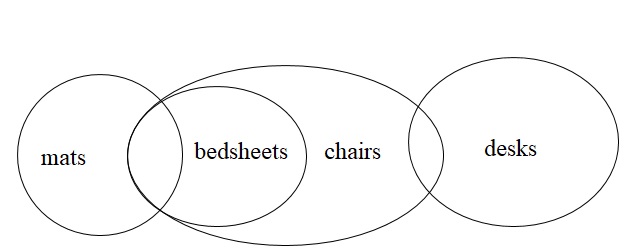Question
Statements: Some mats are bedsheets. All
bedsheets are chairs. Some chairs are desks. Conclusions: I. Some desks are bedsheets. II. Some chairs are mats. III. Some mats are desks. In each question below are given three statements followed by three conclusions numbered I, II and III. You have to take the two given statements to be true even if they seem to be at variance with commonly known facts and then decide which of the given conclusions logically follows from the two given statements, disregarding commonly known facts.Solution
A + I = No conclusion. Hence, conclusion I and III will not follow. Some mats are bedsheets (I) + All bedsheets are chairs (A) = Some mats are chairs (I) ⇒ conversion ⇒ Some chairs are mats (I). Hence, conclusion II will follow. Alternate method:  Conclusion I: Not necessarily true based on given venn diagram. Conclusion II: It is true based on given venn diagram. Conclusion III: Not necessarily true based on given venn diagram.
Conclusion I: Not necessarily true based on given venn diagram. Conclusion II: It is true based on given venn diagram. Conclusion III: Not necessarily true based on given venn diagram.
Which of the following is an atmospheric condition characterized by descending air, clear skies, and dry weather, commonly associated with anticyclones?
Field capacity is the upper limit of available soil moisture. At field capacity, how much is the suction pressure?
Which is the following nutrient is responsible for the seed germination and flowering in plants?
The plant used in saffron spice crop is
What factor primarily determines the selection of a centrifugal pump for irrigation purposes?
In Pure lines election a large number of plants are selected from a ………………… and harvested individually
Aroma in garlic is due to the presence of
Which trap crop used for red hairy caterpillar in Groundnut?
What is a market type based on time span?
Cultivated wheat in India belongs to:
Relevant for Exams:


